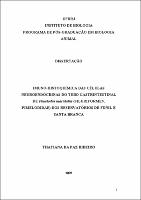Please use this identifier to cite or link to this item:
https://rima.ufrrj.br/jspui/handle/20.500.14407/10886Full metadata record
| DC Field | Value | Language |
|---|---|---|
| dc.contributor.author | Ribeiro, Thatiana da Paz | pt_BR |
| dc.date.accessioned | 2023-12-22T01:44:06Z | - |
| dc.date.available | 2023-12-22T01:44:06Z | - |
| dc.date.issued | 2009-04-27 | |
| dc.identifier.citation | RIBEIRO, Thatiana da Paz. Imuno-histoquímica das células neuroendócrinas do tubo gastrintestinal de Pimelodus maculatus (Siluriformes, Pimelodidae) dos reservatórios de Funil e Santa Branca. 2009. 47 f. Dissertação (Mestrado em Biologia Animal) - Instituto de Ciências Biológicas e da Saúde, Universidade Federal Rural do Rio de Janeiro, Seropédica - RJ, 2009. | por |
| dc.identifier.uri | https://rima.ufrrj.br/jspui/handle/20.500.14407/10886 | - |
| dc.description.abstract | Este trabalho teve por objetivo analisar a influência do habitat na distribuição regional e freqüência relativa das células neuroendócrinas gastrintestinais secretoras de colecistoquinina (CCK-8), gastrina, serotonina (5-Hidroxitriptofano/5HT) em Pimelodus maculatus. Foram utilizados ao todo 18 animais, destes, 12 eram do reservatório da Usina Hidrelétrica de Funil e 6 eram do reservatório de Santa Branca. Após a coleta os peixes foram sacrificados por hipotermia e dissecados em campo. Fragmentos de estômago (região fúndica e pilórica) e intestino foram fixados em líquido de Bouin, processados e emblocados em parafina. Cortes de 5 μm de espessura foram colocados em lâminas previamente tratadas com poly-Llisina e posteriormente submetidos à técnica de imuno-histoquímica. Três tipos de células imunorreativas (IR) foram identificadas na mucosa gástrica e intestinal de P. maculatus. Os anticorpos utilizados foram: anti-CCK-8, anti-gastrina e anti-5-HT. Células IR a CCK-8, gastrina e 5-HT foram encontradas tanto no estômago quanto no intestino nos peixes de ambos os reservatórios. De acordo com o teste estatístico não paramétrico denominado Mann Whitney houve diferença significativa quanto à freqüência relativa das células ao se comparar os ambientes aquáticos e as regiões do tubo gastrintestinal. As células IR à CCK-8 foram mais abundantes na região pilórica que na região fúndica do estômago; no intestino elas se apresentaram como sendo do tipo aberto. As células IR à gastrina foram abundantes e fortemente marcadas nas três regiões estudadas, sendo o tipo celular predominante. As células IR à 5-HT foram mais abundantes nos peixes do reservatório de Funil, sua freqüência foi maior na região pilórica do estômago. | por |
| dc.description.sponsorship | Coordenação de Aperfeiçoamento de Pessoal de Nível Superior | pt_BR |
| dc.format | application/pdf | por |
| dc.language | por | por |
| dc.publisher | Universidade Federal Rural do Rio de Janeiro | por |
| dc.rights | Acesso Aberto | por |
| dc.subject | Pimelodus maculatus | por |
| dc.subject | células neuroendócrinas | por |
| dc.subject | trato gastrintestinal | por |
| dc.subject | imuno-histoquímica. | por |
| dc.subject | neuroendocrine cells | eng |
| dc.subject | gastrointestinal tract | eng |
| dc.subject | immunohistochemistry | eng |
| dc.title | Imuno-histoquímica das células neuroendócrinas do tubo gastrintestinal de Pimelodus maculatus (Siluriformes, Pimelodidae) dos reservatórios de Funil e Santa Branca | por |
| dc.title.alternative | Immunohistochemistry of neuroendocrine cells of the gastrointestinal tube of Pimelodus maculatus (Siluriformes, Pimelodidae) from Funil and Santa Branca reservoirs | eng |
| dc.type | Dissertação | por |
| dc.description.abstractOther | The objective of this work is to analyze the influence of habitat on the regional distribution and relative frequency of gastrointestinal neuroendocrine cells that secrete cholecystokinin octapeptide (CCK-8), gastrin and serotonin (5-HT) in Pimelodus maculatus. All told, 18 fish were utilized, 12 of them taken from Funil Reservoir in the state of Rio de Janeiro and 6 from Santa Branca Reservoir in the state of São Paulo. The fish were sacrificed by hypothermia and dissected in the field. Fragments of the stomach (fundic and pyloric region) and intestine were fixed in Bouin s fluid, processed and embedded in paraffin. Sections 5 μm thick were placed on slides previously treated with poly-L-lysine and then submitted to immunohistochemical analysis. Three types of immunoreactive (IR) cells were identified in the gastric and intestinal mucosa of P. maculatus. The antibodies used were anti-CCK-8, anti-gastrin and anti-5-HT. Cells IR to CCK-8, gastrin and 5-HT were found in the stomach and intestine of the fish from both reservoirs. According to the Mann-Whitney nonparametric test, there was a significant difference in the relative frequency of cells between the two reservoirs and regions of the gastrointestinal tube. The cells IR to CCK-8 were more abundant in the pyloric region than in the fundic region of the stomach. In the intestine they were of the open type. The cells IR to gastrin, the predominant cell type, were abundant and strongly marked in the three regions studied. The cells IR to 5-HT were more abundant in the fish from Funil Reservoir, and their frequency was greatest in the pyloric region of the stomach. | eng |
| dc.contributor.advisor1 | Sales, Armando | pt_BR |
| dc.contributor.advisor1ID | 164.050.567-91 | por |
| dc.contributor.advisor1Lattes | http://lattes.cnpq.br/7306314893432986 | por |
| dc.creator.ID | 096.171.857-92 | por |
| dc.creator.Lattes | http://lattes.cnpq.br/9008487602113690 | por |
| dc.publisher.country | Brasil | por |
| dc.publisher.department | Instituto de Ciências Biológicas e da Saúde | por |
| dc.publisher.initials | UFRRJ | por |
| dc.publisher.program | Programa de Pós-Graduação em Biologia Animal | por |
| dc.subject.cnpq | Ecologia | por |
| dc.thumbnail.url | https://tede.ufrrj.br/retrieve/3703/2009%20-%20Thatiana%20da%20Paz%20Ribeiro.pdf.jpg | * |
| dc.thumbnail.url | https://tede.ufrrj.br/retrieve/17870/2009%20-%20Thatiana%20da%20Paz%20Ribeiro.pdf.jpg | * |
| dc.thumbnail.url | https://tede.ufrrj.br/retrieve/24198/2009%20-%20Thatiana%20da%20Paz%20Ribeiro.pdf.jpg | * |
| dc.thumbnail.url | https://tede.ufrrj.br/retrieve/30601/2009%20-%20Thatiana%20da%20Paz%20Ribeiro.pdf.jpg | * |
| dc.thumbnail.url | https://tede.ufrrj.br/retrieve/36981/2009%20-%20Thatiana%20da%20Paz%20Ribeiro.pdf.jpg | * |
| dc.thumbnail.url | https://tede.ufrrj.br/retrieve/43331/2009%20-%20Thatiana%20da%20Paz%20Ribeiro.pdf.jpg | * |
| dc.thumbnail.url | https://tede.ufrrj.br/retrieve/49731/2009%20-%20Thatiana%20da%20Paz%20Ribeiro.pdf.jpg | * |
| dc.thumbnail.url | https://tede.ufrrj.br/retrieve/56206/2009%20-%20Thatiana%20da%20Paz%20Ribeiro.pdf.jpg | * |
| dc.originais.uri | https://tede.ufrrj.br/jspui/handle/tede/202 | |
| dc.originais.provenance | Made available in DSpace on 2016-04-26T19:00:01Z (GMT). No. of bitstreams: 1 2009 - Thatiana da Paz Ribeiro.pdf: 1670831 bytes, checksum: aca36c36b8d86f4eda9574ea12247485 (MD5) Previous issue date: 2009-04-27 | eng |
| Appears in Collections: | Mestrado em Biologia Animal | |
Se for cadastrado no RIMA, poderá receber informações por email.
Se ainda não tem uma conta, cadastre-se aqui!
Files in This Item:
| File | Description | Size | Format | |
|---|---|---|---|---|
| 2009 - Thatiana da Paz Ribeiro.pdf | 1.63 MB | Adobe PDF |  View/Open |
Items in DSpace are protected by copyright, with all rights reserved, unless otherwise indicated.

